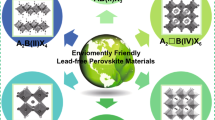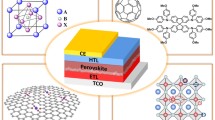Abstract
In recent years, perovskite thin films have attracted much attention in various industries due to their versatile applications. However, the stability problem of perovskite-based solar cells, caused by the susceptibility to degradation due to UV light and moisture, remains a persistent challenge despite the efforts made. This study focuses on the deterioration of CH3NH3PbI3 perovskite thin films, and examines the impact of UV irradiation on their structural, morphological and optical characteristics. For that many CH3NH3Pb(I1−xClx)3 samples with different Cl contents have been synthesized and analyzed by XRD, SEM, UV–Vis Spectroscopy and FTIR technics. The main finding of this study is to demonstrate that it is possible to improve the stability of MAPbI3 under UV light by integration of adequate chloride concentration into the perovskite structure. In fact, experimental observations approve clearly that the stability of CH3NH3Pb(I1−xClx)3 perovskite is significantly improved when the chloride doping concentration is above 20%. Furthermore, the XRD analysis show clearly that the observed UV stability improvement is directly attributed to a structural transition from the tetragonal to the more stable cubic phase.







Similar content being viewed by others
Data availability
Not applicable.
References
A.K. Jena, A. Kulkarni, T. Miyasaka, Halide perovskite photovoltaics: background, status, and future prospects. Chem. Rev. 119(5), 3036–3103 (2019). https://doi.org/10.1021/acs.chemrev.8b00539
S.D. Stranks, G.E. Eperon, G. Grancini, C. Menelaou, M.J.P. Alcocer, T. Leijtens, L.M. Herz, A. Petrozza, H.J. Snaith, Electron-hole diffusion lengths exceeding 1 micrometer in an organometal trihalide perovskite absorber. Science 342(6156), 341–344 (2013). https://doi.org/10.1126/science.1243982
S. De Wolf, J. Holovsky, S.-J. Moon, P. Löper, B. Niesen, M. Ledinsky, F.-J. Haug, J.-H. Yum, C. Ballif, Organometallic halide perovskites: sharp optical absorption edge and its relation to photovoltaic performance. J. Phys. Chem. Lett. 5(6), 1035–1039 (2014). https://doi.org/10.1021/jz500279b
G.E. Eperon, S.D. Stranks, C. Menelaou, M.B. Johnston, L.M. Herz, H.J. Snaith, Formamidinium lead trihalide: a broadly tunable perovskite for efficient planar heterojunction solar cells. Energy Environ. Sci. 7(3), 982–988 (2014). https://doi.org/10.1039/C3EE43822H
S.R. Kumavat, Y. Sonvane, D. Singh, S.K. Gupta, Two-dimensional CH3NH3PbI3 with high efficiency and superior carrier mobility: a theoretical study. J. Phys. Chem. C 123(9), 5231–5239 (2019). https://doi.org/10.1021/acs.jpcc.8b11427
Y.-F. Gu, H.-J. Du, N.-N. Li, L. Yang, C.-Y. Zhou, Effect of carrier mobility on performance of perovskite solar cells. Chin. Phys. B 28(4), 048802 (2019). https://doi.org/10.1088/1674-1056/28/4/048802
L.J. Phillips, A.M. Rashed, R.E. Treharne, J. Kay, P. Yates, I.Z. Mitrovic, A. Weerakkody, S. Hall, K. Durose, Maximizing the optical performance of planar CH3NH3PbI3 hybrid perovskite heterojunction stacks. Sol. Energy Mater. Sol. Cells 147, 327–333 (2016). https://doi.org/10.1016/j.solmat.2015.10.007
T. Etienne, E. Mosconi, F. De Angelis, Dynamical origin of the Rashba effect in organohalide lead perovskites: a key to suppressed carrier recombination in perovskite solar cells? J. Phys. Chem. Lett. 7(9), 1638–1645 (2016). https://doi.org/10.1021/acs.jpclett.6b00564
M.I. Saidaminov, A.L. Abdelhady, B. Murali, E. Alarousu, V.M. Burlakov, W. Peng, I. Dursun, L. Wang, Y. He, G. Maculan, A. Goriely, T. Wu, O.F. Mohammed, O.M. Bakr, High quality bulk hybrid perovskite single crystals within minutes by inverse temperature crystallization. Nat. Commun. 6, 7586 (2015). https://doi.org/10.1038/ncomms8586
P. Li, Y. Chen, T. Yang, Z. Wang, H. Lin, Y. Xu, L. Li, H. Mu, B.N. Shivananju, Y. Zhang, Q. Zhang, A. Pan, S. Li, D. Tang, B. Jia, H. Zhang, Q. Bao, Two-dimensional ch3nh3pbi3perovskite nanosheets for ultrafast pulsed fiber lasers. ACS Appl. Mater. Interfaces 9, 12759–12765 (2017). https://doi.org/10.1021/acsami.7b01709
H.S. Rao, W.G. Li, B.X. Chen, D.B. Kuang, C.Y. Su, In situ growth of 120 cm2 CH3NH3PbBr 3 perovskite crystal film on FTO glass for narrowband-photodetectors. Adv. Mater. (2017). https://doi.org/10.1002/adma.201602639
X.G. Sun, Z.F. Shi, Y. Li, L.Z. Lei, S. Li, D. Wu, T.T. Xu, Y.T. Tian, X.J. Li, Effect of CH3NH3I concentration on the physical properties of solution-processed organometal halide perovskite. J. Alloys Compd. (2017). https://doi.org/10.1016/j.jallcom.2017.02.256
G. Li, Z.K. Tan, D. Di, M.L. Lai, L. Jiang, J.H.W. Lim, R.H. Friend, N.C. Greenham, Efficient light-emitting diodes based on nanocrystalline perovskite in a dielectric polymer matrix. Nano Lett. 15, 2640–2644 (2015). https://doi.org/10.1021/acs.nanolett.5b00235
Y. Zhao, K. Zhu, Organic–inorganic hybrid lead halide perovskites for optoelectronic and electronic applications. Chem. Soc. Rev. 45, 655–689 (2015). https://doi.org/10.1039/C4CS00458B
M.D. McGehee, Perovskite solar cells: continuing to soar. Nat. Mater. 13, 845–846 (2014). https://doi.org/10.1038/nmat4050
A. Uddin, M. Upama, H. Yi, L. Duan, Encapsulation of organic and perovskite solar cells: a review. Coatings 9(2), 65 (2019). https://doi.org/10.3390/coatings9020065
H. Lu, A. Krishna, S.M. Zakeeruddin, M. Grätzel, A. Hagfeldt, Compositional and interface engineering of organic-inorganic lead halide perovskite solar cells. iScience 23(8), 101359 (2020). https://doi.org/10.1016/j.isci.2020.101359
D. Ghosh, C.M. Perez, O. Prezhdo, W. Nie, S. Tretiak, A.J. Neukirch, Impact of composition engineering on charge carrier cooling in hybrid perovskites: computational insights. J. Mater. Chem. C 10(25), 9563–9572 (2022). https://doi.org/10.1039/D2TC01413K
D. Liu, C. Yang, R.R. Lunt, Halide perovskites for selective ultraviolet-harvesting transparent photovoltaics. Joule 2, 1827–1837 (2018)
G. Niu, X. Guo, L. Wang, Review of recent progress in chemical stability of perovskite solar cells. J. Mater. Chem. A 3(17), 8970–8980 (2015). https://doi.org/10.1039/C4TA04994B
A. Fakharuddin, F. De Rossi, T.M. Watson, L. Schmidt-Mende, R. Jose, Research update: behind the high efficiency of hybrid perovskite solar cells. APL Mater. 4(9), 091505 (2016). https://doi.org/10.1063/1.4962143
T.A. Berhe, W.-N. Su, C.-H. Chen, C.-J. Pan, J.-H. Cheng, H.-M. Chen, M.-C. Tsai, L.-Y. Chen, A.A. Dubale, B.-J. Hwang, Organometal halide perovskite solar cells: degradation and stability. Energy Environ. Sci. 9(2), 323–356 (2016). https://doi.org/10.1039/C5EE02733K
T.-Y. Zhu, D.-J. Shu, Polarization-controlled surface defect formation in a hybrid perovskite. J. Phys. Chem. Lett. 12(16), 3898–3906 (2021). https://doi.org/10.1021/acs.jpclett.1c00702
J. Huang, S. Tan, P.D. Lund, H. Zhou, Impact of H2O on organic-inorganic hybrid perovskite solar cells. Energy Environ. Sci. 10(11), 2284–2311 (2017). https://doi.org/10.1039/C7EE01674C
A.A. Melvin, V.D. Stoichkov, J. Kettle, D. Mogilyansky, E.A. Katz, I. Visoly-Fisher, Lead iodide as a buffer layer in UV-induced degradation of CH3NH3PbI3 films. Sol. Energy 159, 794–799 (2018). https://doi.org/10.1016/j.solener.2017.11.054
N. Aristidou, C. Eames, I. Sanchez-Molina, X. Bu, J. Kosco, M.S. Islam, S.A. Haque, Fast oxygen diffusion and iodide defects mediate oxygen-induced degradation of perovskite solar cells. Nat. Commun. 8(1), 15218 (2017). https://doi.org/10.1038/ncomms15218
D. Bryant, N. Aristidou, S. Pont, I. Sanchez-Molina, T. Chotchunangatchaval, S. Wheeler, J.R. Durrant, S.A. Haque, Light and oxygen induced degradation limits the operational stability of methylammonium lead triiodide perovskite solar cells. Energy Environ. Sci. 9(5), 1655–1660 (2016). https://doi.org/10.1039/C6EE00409A
E.J. Juarez-Perez, L.K. Ono, I. Uriarte, E.J. Cocinero, Y. Qi, Degradation mechanism and relative stability of methylammonium halide based perovskites analyzed on the basis of acid-base theory. ACS Appl. Mater. Interfaces 11(13), 12586–12593 (2019). https://doi.org/10.1021/acsami.9b02374
N. Ahn, K. Kwak, M.S. Jang, H. Yoon, B.Y. Lee, J.-K. Lee, P.V. Pikhitsa, J. Byun, M. Choi, Trapped charge-driven degradation of perovskite solar cells. Nat. Commun. 7(1), 13422 (2016). https://doi.org/10.1038/ncomms13422
A. El-Yahyaoui, B. Jaber, L. Laanab, M. El Mahi, E.M. Lotfi, The effect of temperature and distance of hot airflow on the quality of MAPbCl3 thin films grown by sol–gel deposition. J. Mater. Sci. 34, 252 (2023)
S.-W. Lee, S. Kim, S. Bae, K. Cho et al., UV degradation and recovery of perovskite solar cells. Sci. Rep. 6, 38150 (2016). https://doi.org/10.1038/srep38150
W. Li, W. Zhang, S. Van Reenen, R.J. Sutton, J. Fan, A.A. Haghighirad, M.B. Johnston, L. Wang, H.J. Snaith, Enhanced UV-light stability of planar heterojunction perovskite solar cells with Caesium Bromide interface modification. Energy Environ. Sci. 9, 490–498 (2016). https://doi.org/10.1039/C5EE03522H
Y. He, S. Xin, Y. Ren, S. Li, J. He, J. Li, Fu. Chunlin, Effects of anti-solvent temperature on microstructures and photovoltaic properties of TiO2@MAPbI3 core-shell nanowire arrays. Physica E 147, 115610 (2023)
M. Ouafi, B. Jaber, L. Atourki, R. Bekkari, L. Laanab, Improving UV stability of MAPbI3 perovskite thin films by bromide incorporation. J. Alloys Compd. 746, 391–398 (2018)
R. Bekkari, L. Laânab, B. Jaber, Effect of the bivalent dopant ionic radius, electronegativity and concentration on the physical properties of the sol–gel-derived ZnO thin films. J. Mater. Sci. (2020). https://doi.org/10.1007/s10854-020-04078-z
X. Zheng, B. Chen, J. Dai, Y. Fang, Y. Bai, Y. Lin, H. Wei, X.C. Zeng, J. Huang, Defect passivation in hybrid perovskite solar cells using quaternary ammonium halide anions and cations. Nat. Energy 2, 17102 (2017)
D. Yerezhep, Z. Omarova, A. Aldiyarov, A. Shinbayeva, N. Tokmoldin, IR spectroscopic degradation study of thin organometal halide perovskite films. Molecules 28, 1288 (2023). https://doi.org/10.3390/molecules28031288Academic
Acknowledgments
The authors are grateful to the National Center for Scientific and Technical Research (CNRST) of Rabat- Morocco for allowing us the use of all technical facilities of the UATRS Division.
Funding
No funding received for this work.
Author information
Authors and Affiliations
Contributions
The authors confirm contribution to the paper as follows: Study conception and experimental preparations: Asmae EL-YAHYAOUI; Data collection: Asmae EL-YAHYAOUI, El Mostapha LOTFI; Analysis and interpretation of results: Asmae EL-YAHYAOUI, Boujemaâ JABER, Larbi LAANAB; Manuscript write out: Asmae EL-YAHYAOUI. All authors reviewed the results and approved the final version of the manuscript.
Corresponding author
Ethics declarations
Conflict of interest
All authors declare that they have no conflicts of interest.
Ethical approval
Ethical approval is not applicable for this article.
Additional information
Publisher's Note
Springer Nature remains neutral with regard to jurisdictional claims in published maps and institutional affiliations.
Rights and permissions
Springer Nature or its licensor (e.g. a society or other partner) holds exclusive rights to this article under a publishing agreement with the author(s) or other rightsholder(s); author self-archiving of the accepted manuscript version of this article is solely governed by the terms of such publishing agreement and applicable law.
About this article
Cite this article
El-Yahyaoui, A., Jaber, B., Laanab, L. et al. Chloride incorporation for the stability improvement of the MAPI hybrid perovskite. J Mater Sci: Mater Electron 35, 798 (2024). https://doi.org/10.1007/s10854-024-12455-1
Received:
Accepted:
Published:
DOI: https://doi.org/10.1007/s10854-024-12455-1




